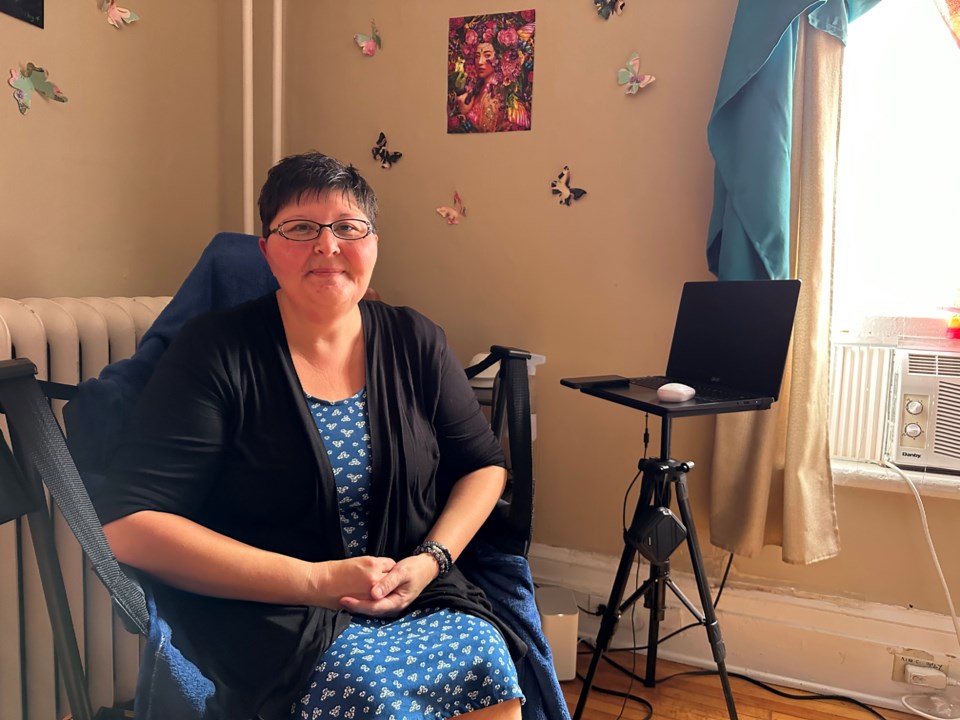A local woman has grown weary with her wait for affordable housing after being on the County of Simcoe’s wait list for 14 years.
Anne Tasse signed up for the county’s geared-to-income housing wait list in 2009, when she was given an estimated wait of 10 years to access affordable housing.
However, her wait continues.
Tasse lives with numerous disabilities, and she relies on income received through the Ontario Disability Support Program and the Canada Pension Plan to get by.
She lives in a small bachelor apartment in Orillia, and her current rent — at $850 per month — represents well over 50 per cent of her monthly income.
“I’m almost 50 years old. When is my life going to be OK?” Tasse told OrilliaMatters. “When I applied, it was supposed to be a 10-year waiting list. After 11 and 12, you’re like, ‘OK, what’s going on?’”
After paying her bills, Tasse is left with little money, and she occasionally relies on food banks to get through the month.
She hopes to one day be able to afford some of life’s simple pleasures, like going out to eat on occasion, or perhaps taking a trip somewhere.
“It’s been so long since I’ve gone anywhere,” she said. “I’m not asking for a lottery. I’ve worked hard until the point that I couldn’t anymore. I’ve contributed; I still contribute. I just want to be valued.”
Since receiving disability payments, she has been able to work part-time on occasion, and she said she does not live on disability by choice.
Despite her efforts, she has not been able to find housing that is truly affordable for her.
She has worked a number of jobs over the years but has found she either burns out or, over time, is subjected to workloads she is not able to handle.
Even when she is able to work, she is limited in how much she is permitted to make through the Canada Pension Plan, she said, which has made it difficult to get by over the years.
“If I’m only making $5,600 (per year), do you actually think I can support myself?” she asked.
Tasse hopes to see more truly affordable housing made available to people, especially rent-geared-to-income developments, which charge rent based on a percentage of someone’s income.
She pointed out, for example, she will likely not be able to afford a place in the upcoming 130-unit County of Simcoe hub on West Street North, which will be rented at an average of 80 per cent market rate values.
“I’ve reached out to the local politicians here, reached out to (Ontario) Housing Minister Steve Clark, and (Prime Minister Justin) Trudeau,” she said. “They all went back to their 10-year affordable housing plan. I emailed them back and I said, ‘OK, but your affordability is ignoring geared-to-income (rentals).’ That’s where there’s that division.”
A geared-to-income rental, Tasse said, would charge about 30 per cent of her monthly income, as opposed to more than 50 per cent, and that would afford her an additional few hundred dollars per month, which she said would allow her to get by and enjoy her life to a greater degree.
After waiting for 14 years, however, she feels discouraged.
“I feel like I’m getting pushed behind year after year, and it’s going on 15 years now,” she said. “When is it my turn?”
County officials said there are 3,946 social housing units across Simcoe County — with an additional 931 private units — and 2,668 are rent-geared-to-income units.
Andrew Scavarelli, the county’s director of Ontario Works, said the county has been successful in adding more affordable housing inventory over the past decade and is currently working on its next 10-year plan.
“As part of Our Community 10-Year Affordable Housing and Homelessness Prevention Strategy, which covers the period of 2014 to 2024, we set out to achieve 2,685 new units of affordable housing across the region,” he said in a statement to OrilliaMatters. “We are happy to say that as of Dec. 31, 2022, we exceeded that goal by generating 2,775 new units being created since 2014, one year ahead of schedule.”
In 2022, the county moved 262 individuals into rent-geared-to-income housing, Scavarelli said, noting it can take a long time to move people into such units as they are typically occupied long-term.
In recent years, the wait list has grown, with 4,343 households listed in 2019 and 4,877 listed in 2022.
A number of factors can affect the wait time, said Scavarelli, who noted the county generally does not give people an estimated wait time.
While housing is allocated on a chronological basis, special priority applicants — like victims of domestic abuse or human trafficking — are required, under provincial legislation, to be prioritized.
“A special priority applicant can bump a chronological applicant by the nature of the priority, and households can also be on more than one housing provider wait list,” Scavarelli said.
The county hub on West Street North will provide some rent-geared-to-income housing, he said, but will primarily offer affordable housing.
